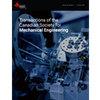纳米生物柴油对VCR柴油机性能的影响
IF 1
4区 工程技术
Q4 ENGINEERING, MECHANICAL
Transactions of The Canadian Society for Mechanical Engineering
Pub Date : 2022-12-02
DOI:10.1139/tcsme-2022-0077
引用次数: 0
摘要
研究了B100A30C30单缸可变压缩比柴油机的燃烧、效率和排放特性。为了产生均匀的溶液,超声波发生器与百万分之30(ppm)浓度的碳化硅(SiC)和碳纳米管(CNT)结合使用,这两种常见的纳米颗粒存在于燃料组合中。在燃烧过程中,纳米颗粒更大的表面积与体积比提高了混合性和化学反应性,改善了柴油发动机的燃烧、性能和排放特性。纳米颗粒发动机(B20A30C30)的制动热效率比普通颗粒发动机(B100)高20%。之后,氮氧化物排放减少了38%,一氧化碳排放减少了68%,碳氢化合物排放减少了52%,烟雾排放减少了48%。本文章由计算机程序翻译,如有差异,请以英文原文为准。
The effects of nanoparticles as a biodiesel ingredient on the performance of a VCR diesel engine
The combustion, efficiency, and emission properties of a single-cylinder variable compression ratio diesel engine are examined in this research (B100A30C30). To create a homogeneous solution, the ultrasonicator is used in conjunction with a 30 part per million (ppm) concentration of Silicon Carbide (SiC) and Carbon Nanotubes(CNT),two common nanoparticles found in fuel combinations. The increased mixing and chemical reactivity offered by nanoparticles' greater surface area to volume ratio during combustion has improved the combustion, performance, and emission characteristics of diesel engines. The engine with nanoparticles (B20A30C30) has a thermal efficiency of braking that is 20 % higher than the engine with regular particles (B100). Following that, nitrogen oxide emissions reduced by 38%, carbon monoxide emissions by 68%, hydrocarbon emissions by 52%, and smoke emissions by 48%.
求助全文
通过发布文献求助,成功后即可免费获取论文全文。
去求助
来源期刊
CiteScore
2.30
自引率
0.00%
发文量
53
审稿时长
5 months
期刊介绍:
Published since 1972, Transactions of the Canadian Society for Mechanical Engineering is a quarterly journal that publishes comprehensive research articles and notes in the broad field of mechanical engineering. New advances in energy systems, biomechanics, engineering analysis and design, environmental engineering, materials technology, advanced manufacturing, mechatronics, MEMS, nanotechnology, thermo-fluids engineering, and transportation systems are featured.

 求助内容:
求助内容: 应助结果提醒方式:
应助结果提醒方式:


